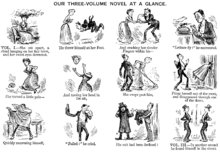陳腔濫調

陳腔濫調(法語:Cliché)是一種表達方法、概念、或是藝術相關作品具備的元素,因為過於頻繁地被使用,以至於喪失了它原本的意義或原先想達成的效果,甚至於到達毫無新意、無趣而且惱人的程度。尤其在這個概念本來被認為是很有意思的或是創新的情況下。[1]。
用法[编辑]

陳腔濫調在各種辭典介紹的衍生形容詞中具有相同含義[3][4][5][6]。
參考資料[编辑]
- ^ Gary Blake and Robert W. Bly, The Elements of Technical Writing, pg. 85. New York City: Macmillan Publishers, 1993. ISBN 0020130856
- ^ Freeman, Michael. Nature and Landscape Photography. Lark Books. 2004: 36 [2009-07-02]. ISBN 1-57990-545-5.
- ^ cliche. The American Heritage Dictionary of the English Language, Fourth Edition. n.d. [2010-10-21]. (原始内容存档于2005-01-09).
- ^ cliché. Merriam-Webster Online Dictionary. 2010 [2010-02-21]. (原始内容存档于2019-08-05).
- ^ cliché. Dictionary.com Unabridged. n.d. [2010-02-21]. (原始内容存档于2016-03-03).
- ^ Brown, Lesley, editor. cliché. New Shorter Oxford English Dictionary. Clarendon Press. 1993. ISBN 0-19-861271-0.
參見[编辑]
| |||||||||||||||||||||||||||||||||||||||||||||||||||||||||
|
